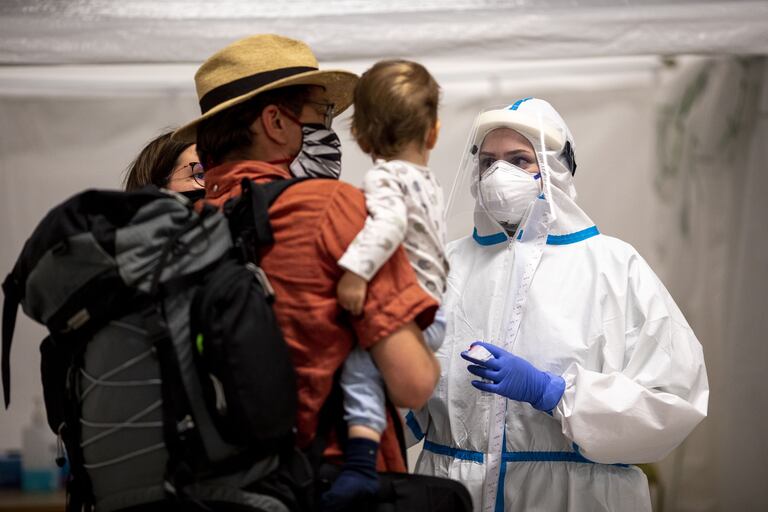Germany, the country that dazzled the world by its management in the first months of the pandemic, has been registering a peak of infections these days, which has not stopped growing since the end of July. This Thursday, the Robert Koch institute estimated new positives in the last 24 hours at 1,707 and deaths at ten, which is the highest number of infections since the end of last April in a country of 83 million inhabitants. Family gatherings, friends and workplaces, together with the return of vacationers from other countries and the increase in diagnostic tests are among the reasons for this increase, which has put health and political authorities on guard.
Concern is increased as it is a spread that is not concentrated in large outbreaks and therefore more controllable. “In the past weeks, the cases of covid-19 have increased considerably in many federal states and the number of municipalities with zero cases during a period of seven days has decreased notably. This trend is very worrying ”, indicates the Robert Koch Institute in its latest daily report. "Celebrations with family and friends and returning travelers, especially the youngest, contribute to the increase in cases," adds the institute.
In total, the German epidemiological reference center has recorded 228,621 cases since the beginning of the epidemic and 9,253 deaths, representing a mortality rate of 4%. The reproduction rate of the virus, that is, the average number of infections by a single person, continues above the threshold of one (1.03), considered key to contain the spread.
“It is a level of contagion that is still controllable, but new measures should be taken to stop it growing. If this continues for months, it will be impossible to control ”, explains to this newspaper Jonas Schmidt-Chanasit, one of the most recognized virologists in the country. Experts indicate that the current one is a linear and not exponential growth, which Schmidt-Chanasit attributes in part "to the fact that many people maintain a safe distance, wash their hands and wear a mask." This expert from the University of Hamburg insists on the importance of avoiding closed spaces and fears that in autumn, with the drop in temperatures and the change in lifestyle, the epidemiological situation will worsen.
More information
- Outbreaks force Europe to advance restrictions
- The school year begins in northern Germany in the heat of struggle to contain the outbreaks
On Tuesday, Chancellor Angela Merkel ruled out relaxing measures to contain the virus, which include maintaining a safe distance and wearing a mask in closed places such as shops and on public transport. "The good news is that if we follow the rules, it is possible to maintain an openness of public life," he said on a visit to North Rhine-Westphalia, the most affected German Land . "In any case, there can be no relaxation of measures now," she said.
The so-called imported cases, that is, travelers who may have been infected in other countries, accounted for 39% of positive cases last week, according to data from the Robert Koch Institute. Kosovo, Turkey and Croatia are the three countries of origin for the highest number of imported cases. Spain is in sixth place on the list, with 222 cases reported in the last three weeks, compared to 1,755 in Kosovo.
The German institute also details that in Kosovo and Turkey there are cases that include a high number of children and middle-aged people. In Spain and Croatia, the probability of contagion increases in people between 20 and 24 years old, which points to tourism as the objective of the trip. “Families that come from countries like Kosovo, travel by car and do not go through airports. The government is trying to convince them now to take the test, ”explains Schmidt-Chanasit.
Since the beginning of August, Germany has carried out free diagnostic tests at points of entry to the country such as airports, train stations or highways, for those who come from the so-called risk areas. Travelers must be quarantined until they receive a negative test result. Spain, with the exception of the Canary Islands, is on the German Government's list of risk areas. This Thursday, Croatian coastal regions have been included in the risk list.
The end of summer could reduce the number of positive travelers. For this reason, Schmidt-Chanasit considers that the real problem is the infections that occur within the borders of Germany, in family gatherings and in the workplace. "It is clear that infections grow when many people get together, especially indoors," recalls the virologist. The Robert Koch Institute indicates that the emission of aerosols increases dramatically when singing, laughing or speaking loudly. "In closed rooms, the risk of transmission increases significantly, even if a distance of more than one and a half meters is maintained," the institute indicates in its latest report.
Finally, Schmidt-Chanasit attributes the increase in cases, in part, to many more tests being performed. Last week 875,524 were made, with a total of 8,407 positives. This means that the percentage of positives has remained stable in the last three weeks, but has increased compared to the previous ones.
West Germany continues to account for the largest number of cases, with North Rhine-Westphalia leading the way. Bavaria, Baden-Württemberg and Hessen are among the most affected German states. The rebound in cases also coincides with a drop in the average age of those infected.
The staggered return to classrooms since the first week of August has caused the closure of some schools, but according to experts, it is still early to determine the epidemiological impact of the new school year.
Information about the coronavirus
- Here you can follow the last hour on the evolution of the pandemic
- This is how the coronavirus curve evolves in Spain and in each autonomy
- Search engine: The new normal by municipalities
- Questions and answers about the coronavirus
- Guide to action against the disease

